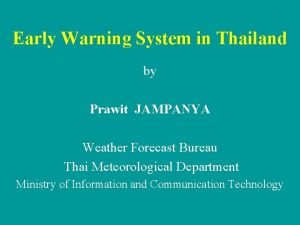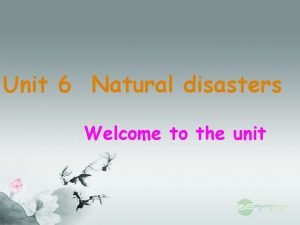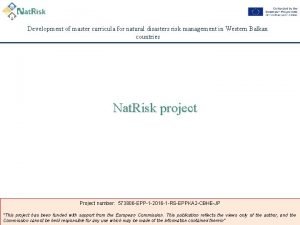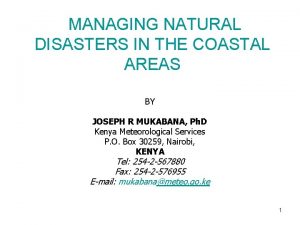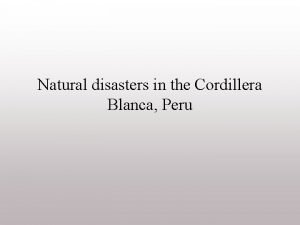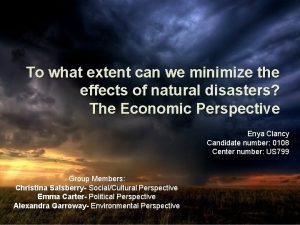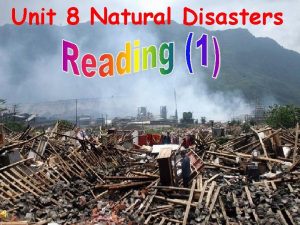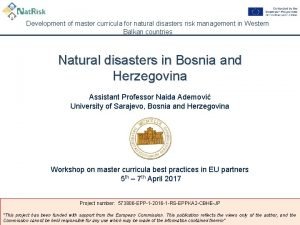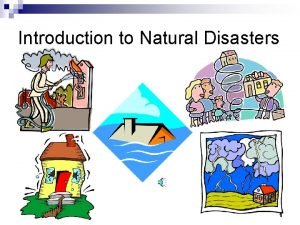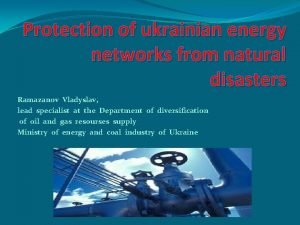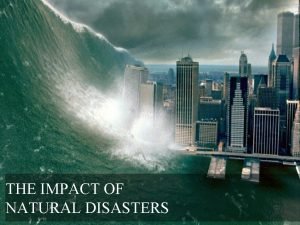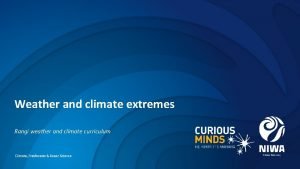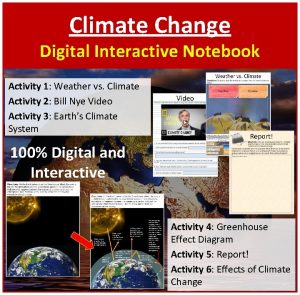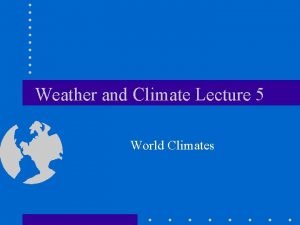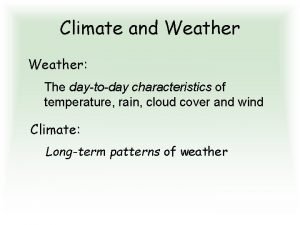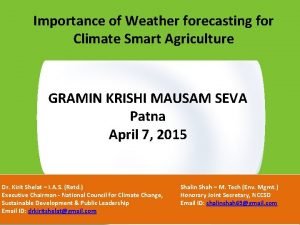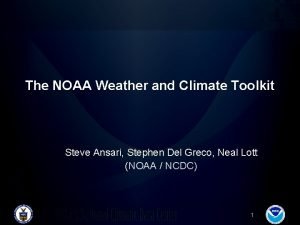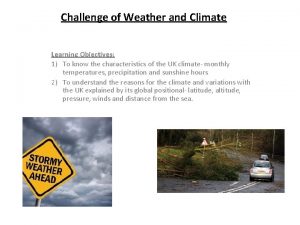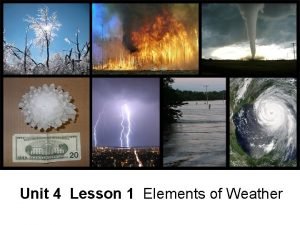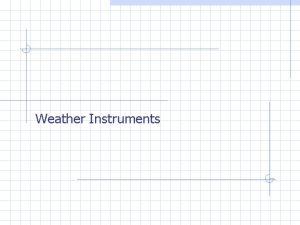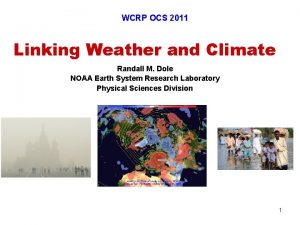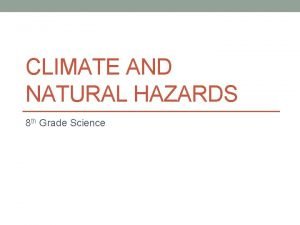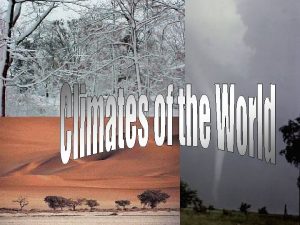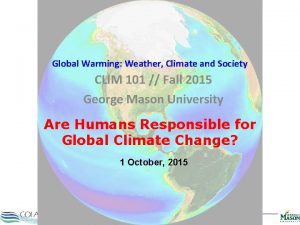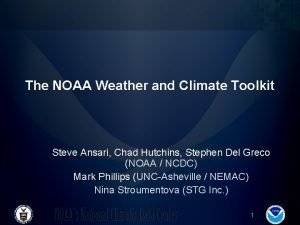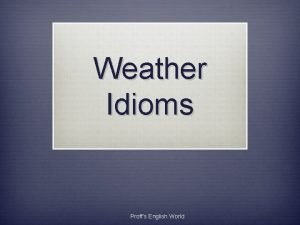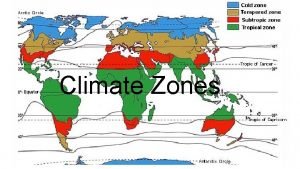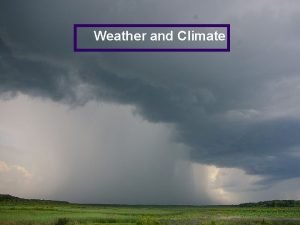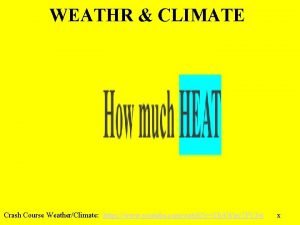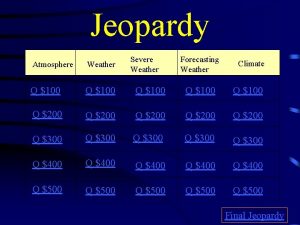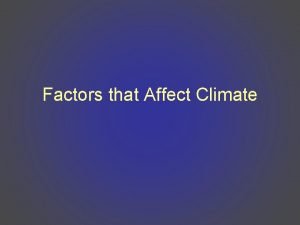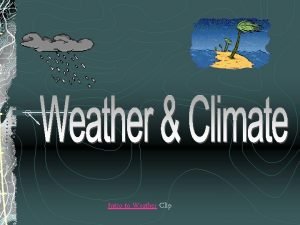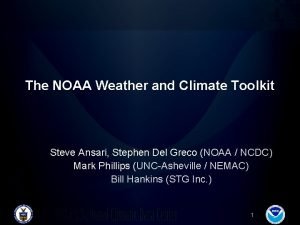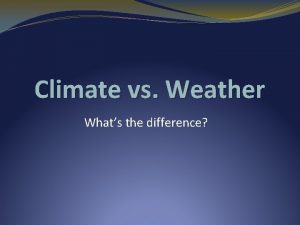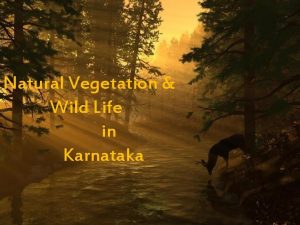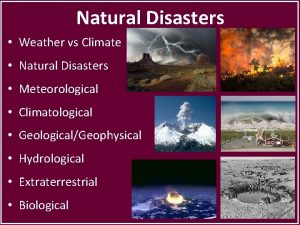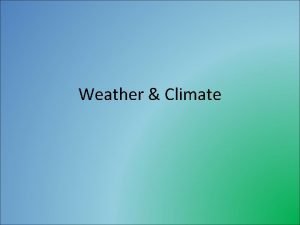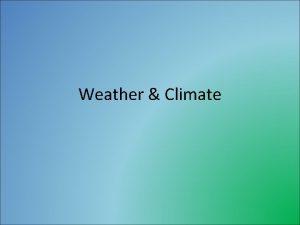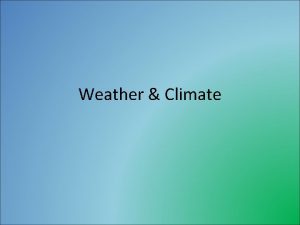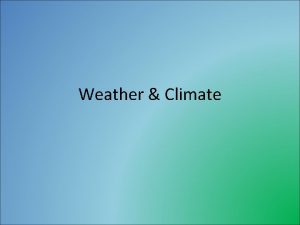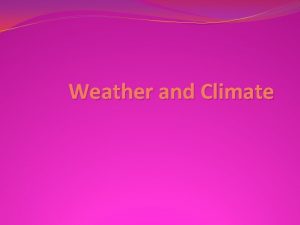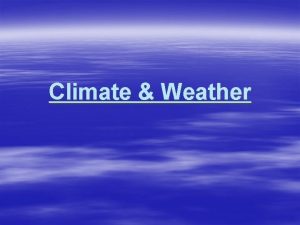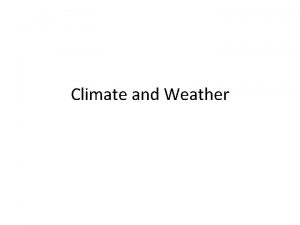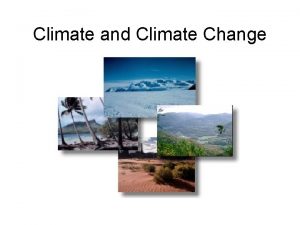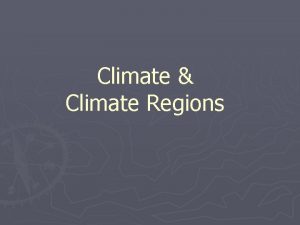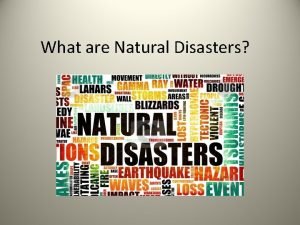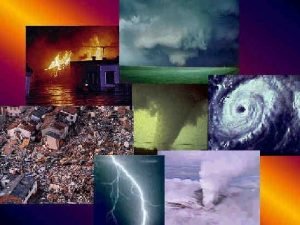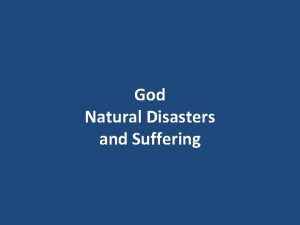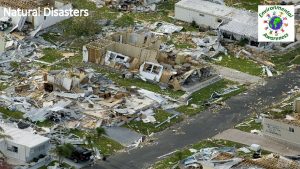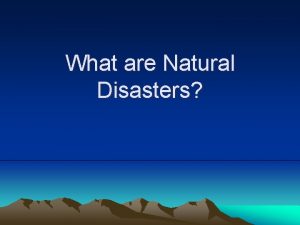Natural Disasters Weather vs Climate Natural Disasters Meteorological





















































- Slides: 53

Natural Disasters • Weather vs Climate • Natural Disasters • Meteorological • Climatological • Geological/Geophysical • Hydrological • Extraterrestrial • Biological

Weather vs Climate • Weather – Local atmospheric conditions at a given time – Atmosphere: layer of gases and particles surrounding and protecting Earth – Normal: everyday conditions – Severe: relatively rare, dangerous conditions

Weather vs Climate • Climate – Long-term weather – Averages and extremes

Natural Disasters • Events caused by natural processes • Severe property or environmental damage • Loss of life

Natural Disasters • 6 categories – Meteorological (weather) – Climatological (climate) – Geological/geophysical (Earth) – Hydrological (water) – Extraterrestrial (outer space) – Biological (life)

Meteorological • • • Thunderstorms Tornadoes Hurricanes Blizzards Ice storms Hailstorms

Thunderstorms • Result of air movement Stop at 3: 11 • Recall: Rising air (updraft) forms clouds • Clouds can build up until they become cumulonimbus clouds – Towering: 10 km (33, 000 ft) or taller – Made of mostly liquid water – Ice crystals form at the top – Responsible for thunderstorms

Thunderstorms • Precipitation falls through cloud, carrying air with it • Air radiates out from bottom of cloud as wind

Thunderstorms • Lightning: – Liquid (rising) and frozen (falling) droplets collide – Frozen droplets pull electrons off liquid droplets – Creates charge difference between top (positive) and bottom of cloud (negative) – Charge needs to be released lightning – Cloud-to-ground: positive charge builds up on Earth’s surface beneath cloud


Thunderstorms • Thunder – Caused by lightning – Lightning heats up air • Up to 50, 000 o. F (27, 760 o. C) – 5 x hotter than the Sun’s surface – Tube of air around lightning expands and contracts, causing vibration – Vibration = loud thunderclap – Vibrations continue, getting progressively smaller = rumbling

Thunderstorms • Dangers – Aircraft - turbulence – Heavy winds and rain – Hail – Lightning strikes – Flooding – Tornadoes

Tornadoes • Spinning columns of air • Most destructive natural disaster • Winds: 400 kilometers (250 miles) per hour or more • Formation – Ascending warm air is trapped under a layer of cold air – Can’t descend because air below it is too dense – Air molecules keep moving, forming a funnel cloud

Tornadoes • Warnings – Greenish or very dark sky – Large hail – Funnel cloud – Loud roar like a train • Dangers – High winds

Hurricanes • Also called typhoons or cyclones • Low pressure areas that form in tropical seas • Collect winds • Winds rise in tube shape, warm air descends in center of tube (eye) • Move out of tropical seas and keep pulling in winds

Hurricanes • Average diameter: 600 km (375 mi) • Wind speeds: 119 km (74 mi) per hour or more • Categories – 1: 119 -153 km/hr (74 -95 mph) – 2: 154 -177 km/hr (96 -110 mph) – 3: 178 -208 km/hr (111 -129 mph) – 4: 209 -251 km/hr (130 -156 mph) – 5: ≥ 252 km/hr (≥ 157 mph)

Hurricanes • Dangers – High winds – Flooding – Storm surge – Tornadoes

Blizzards • Snow formation – Ice crystals in clouds combine – Snow falls at <2 o. C (35. 6 o. F) • Blizzard: intense winter storm with winds ≥ 56 km/hr (35 mph)

• Dangers Blizzards – High winds (can reach hurricane speeds) – Snow accumulation – Cold – Flooding Thundersnow Start @2: 04 Stop @4: 11

Ice storms • Ice formation – Snow melts as it falls – Becomes freezing rain in colder air beneath clouds – Freezing rain falls through layer of subfreezing air ice • Dangers – Ice accumulation

Hailstorms • Hail formation – Forms in thunderstorms – Updrafts carry water droplets into very cold parts of the atmosphere – Droplets freeze and combine with one another – Size: ¼ in to >4 in • Dangers – Property damage – In combination with winds: personal injury

Climatological • Drought • Extreme heat • Wildfires

Drought • • Long-term low rain/snowfall Water body reductions Low water availability Dangers – Agricultural disasters – Danger to animals and plants – Danger to environment – Water contamination – Wildfires

Extreme Heat • Long-term high heat and/or humidity • High pressure dome heats up upper atmosphere and traps air near ground • Ground-level air heated up by Earth’s surface • Dangers – Health problems/death – Environmental/agricultural damage – Wildfires

Wildfires • Uncontrolled fires in natural areas • Dangers – Injury and death: animals and plants – Damage and destruction: structures – Air pollution – Soil structure weakening floods/landslides

Geological/Geophysical • Due to plate tectonics and underground processes • Earthquakes • Volcanoes • Landslides/avalanches • Sinkholes

Earthquakes • Shaking ground • Unpredictable • Tectonic plates slide past each other and get stuck • Energy built up is released when they slip apart

Earthquakes • Fault: cracks in crust between rock masses • Energy released as a seismic wave • Focus: point of energy release within Earth’s crust • Epicenter: point on surface above focus • Dangers – Property damage – Personal injury/death – Tsunamis

Volcanoes • Vents in Earth’s crust • Molten magma escapes at vents as lava

Volcanoes • Occur at subduction zones, divergent plate boundaries, and within plates – Subduction zones: lower plate melts and rises, mixing with gases and exploding through surface – Divergent boundaries: rift volcanoes • Magma ascends into space left behind when plates move apart • Less explosive

Volcanoes • Occur at subduction zones, divergent plate boundaries, and within plates – Within plates: hotspot volcanoes • Column of magma ascends from deep within mantle • Magma pushes up through crust • Plate continues to move, resulting in chain of volcanoes (e. g. Hawaii)

Volcanoes • Dangers – Explosive eruptions • Burning lava • Hot cinders • Ash • Other flying debris – Lava flows

• Dangers Volcanoes – Pyroclastic flows • Masses of ash, gas, and other materials • Hot: 100 -700 o. C (212 -1300 o. F) • Fast: 160 km (100 mi) per hour – Gas clouds – Ash accumulation – Tsunamis

Landslides/Avalanches • Earth, rock, ice, snow, and/or other debris moving down a hill or mountain • Triggered by ground movement (e. g. earthquake, volcano), heavy rainfall, erosion, or human intervention • Landslides: earth, rock, mud • Avalanche: ice, snow

Landslides/Avalanches • Dangers – Destruction of natural environments/human communities – Can bury animals (including humans)

Sinkholes • Sunken ground • Depth: <0. 3 m (1 ft) to >30 m (100 ft) • Crust beneath the surface gets hollowed out – Usually due to groundwater erosion • Dangers – Property damage (i. e. can swallow entire buildings) – Personal injury/death

End of Day 1

Hydrological • Tsunamis • Floods • Limnic eruptions

Tsunamis • Massive, rapidly moving waves • Caused by water displacement at sea – Earthquake – Volcano – Landslide – Meteorite strike • Size: >30 m (100 ft) high • Speed: up to 900 km/hr in open ocean

Tsunamis • Dangers – Force of water: property damage, injury, death – Drowning – Wash away soil – Displace animal communities – Flooding – Soil and water contamination – Fires

Floods • Water inundation on normally-dry land • Second-most destructive natural disaster • Few inches to tens of feet in depth • Four types – Overbank – Flash – Coastal – Ice jam

Floods • Overbank – Usually due to excess rain or snowmelt causing a body of water to overflow its banks – Covers floodplain (surrounding land) – Typically slow and long-lasting • Flash – Occur in a matter of hours – Average speed: ~3 m/s (9 ft/s) – Can move heavy debris (~100 pounds)

• Coastal Floods – Effects of tsunamis and hurricane storm surges – Can be fast and cover large swaths of land • Ice jam – Chunks of ice dam a water body – Water piles up behind ice and overflow banks – Jam breakage leads to flash floods downstream

Floods • Dangers – Destruction – Wash away soil – Water and soil contamination – Litter and debris left behind – Mold – Water-borne diseases

Limnic eruptions • Rare (only 2 recorded) • Deadly • Explosions of lakes formed in dormant volcanic craters in areas with relatively consistent temperatures • Gases leak from magma into lake floor • Lake water traps gases • Temperature changes would allow mixing and gas release at surface

Limnic eruptions • Gases build up • Lake disturbance (e. g. landslide) causes gases to explode upwards • Dangers – Cloud of poisonous gas widespread animal death

Extraterrestrial • Meteorite/asteroid impacts • Solar storms

Meteorite/Asteroid • Space rock that hits the Earth • Dangers – Widespread destruction (much like a nuclear bomb) – Air pollution – Sun blockage due to debris – Mass extinction (e. g. likely what caused the dinosaur extinction)

Solar Storms • Explosions on the surface of the Sun • Energy and magnetic waves from solar storms can reach Earth • Dangers – Electric grid and satellite disruption/damage – Solar radiation (especially dangerous for astronauts in International Space Station)

Biological • Epidemics/pandemics • Animal infestations

Epidemics/Pandemics • Unusually high spread of infectious disease – Contagion – Vector-borne • Epidemic: population-, community-, and/or regional-level • Pandemic: larger region, such as a continent, or worldwide

Epidemics/Pandemics • Dangers – Widespread illness/death • Examples – Avian flu – Cholera – Ebola – HIV/AIDS – Malaria

Animal Infestations • Widespread immigration or proliferation of animals that affect humans, other animals, crops, and property • Dangers – Property damage – Agricultural disasters – Environmental damage – Disease – Native species declines
 Natural hazards vs natural disasters
Natural hazards vs natural disasters Which weather map symbol is used to represent violently
Which weather map symbol is used to represent violently Satellite radar
Satellite radar Climate change 2014 mitigation of climate change
Climate change 2014 mitigation of climate change Three natural disasters
Three natural disasters Natural disasters
Natural disasters Introduction natural disasters
Introduction natural disasters Natural disasters in the cordillera region
Natural disasters in the cordillera region Natural disasters conclusion for project
Natural disasters conclusion for project Unit 8 natural disasters
Unit 8 natural disasters Natural disasters
Natural disasters Disaster definitions
Disaster definitions Natural disasters conclusion for project
Natural disasters conclusion for project Natural disasters listening comprehension
Natural disasters listening comprehension Unit 9 natural disasters
Unit 9 natural disasters Ancient natural disasters
Ancient natural disasters Positive effects of earthquakes
Positive effects of earthquakes Environmental effect of disaster
Environmental effect of disaster Ancient natural disasters
Ancient natural disasters Kahoot quiz
Kahoot quiz Weather and climate interactive activities
Weather and climate interactive activities Crash course kids weather
Crash course kids weather Cimates
Cimates Characteristics of weather and climate
Characteristics of weather and climate Importance of weather and climate to agriculture
Importance of weather and climate to agriculture Weather climate toolkit
Weather climate toolkit Objectives of weather and climate
Objectives of weather and climate World geography chapter 3 weather and climate
World geography chapter 3 weather and climate Elements of weather lesson plan
Elements of weather lesson plan Instruments used to measure weather and climate
Instruments used to measure weather and climate Conclusion of weather and climate
Conclusion of weather and climate Similarities of series and parallel circuits
Similarities of series and parallel circuits Explain how some hail can become baseball sized
Explain how some hail can become baseball sized Factors affecting climate
Factors affecting climate Brainpop precipitation
Brainpop precipitation Weather climate and society
Weather climate and society Noaa weather and climate toolkit
Noaa weather and climate toolkit Cloud nine idiom
Cloud nine idiom 12 climate zones map
12 climate zones map What is the difference between weather and climate
What is the difference between weather and climate Weathr
Weathr Weather and climate jeopardy
Weather and climate jeopardy How do prevailing winds affect climate
How do prevailing winds affect climate What happens when the temperature of the air cools brainpop
What happens when the temperature of the air cools brainpop Noaa weather and climate toolkit
Noaa weather and climate toolkit Poem fashion
Poem fashion Whats the difference between weather and climate
Whats the difference between weather and climate It's rainy and windy
It's rainy and windy Weather and whether
Weather and whether Station model weather symbols
Station model weather symbols Heavy weather by weather report
Heavy weather by weather report Whether the weather be cold
Whether the weather be cold Capital weather gang weather wall
Capital weather gang weather wall Vegetation
Vegetation


